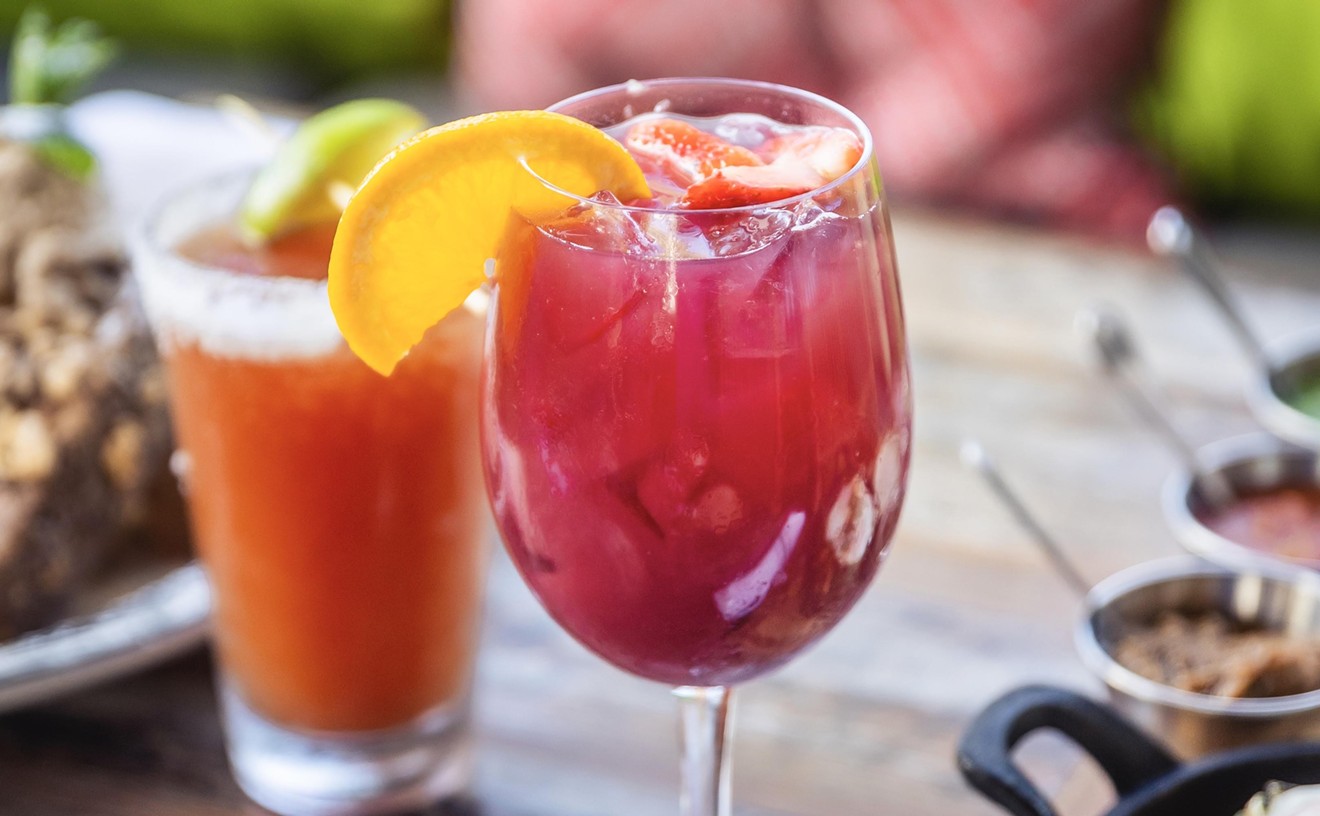Chef Rick Bayless' New Cookbook Gives You an Excuse to Eat Mexican Every Day (Recipe)
Chef Rick Bayless is a man of many talents. He simultaneously maintains an impressive reputation as a chef, restaurateur, author, TV personality, actor, dancer, environmental advocate, and philanthropist. But most of all, Bayless wants you to eat more Mexican food. Bayless' fascination with Mexican culture and cuisine is ingrained in all...
May 13, 2015
[
{
"name": "GPT - Billboard - Slot Inline - Content - Labeled - No Desktop",
"component": "16971022",
"insertPoint": "2",
"requiredCountToDisplay": "2"
},{
"name": "Editor Picks",
"component": "15769925",
"insertPoint": "4",
"requiredCountToDisplay": "1"
},{
"name": "Inline Links",
"component": "16575154",
"insertPoint": "8th",
"startingPoint": 8,
"requiredCountToDisplay": "7",
"maxInsertions": 25
},{
"name": "GPT - Rectangle 2x - Slot Auto-select - Labeled",
"component": "15782206",
"insertPoint": "8th",
"startingPoint": 8,
"requiredCountToDisplay": "7",
"maxInsertions": 25
},{
"name": "Inline Links",
"component": "16575154",
"insertPoint": "8th",
"startingPoint": 12,
"requiredCountToDisplay": "11",
"maxInsertions": 25
},{
"name": "GPT - Leaderboard to Tower - Slot Auto-select - Labeled",
"component": "15782207",
"insertPoint": "8th",
"startingPoint": 12,
"requiredCountToDisplay": "11",
"maxInsertions": 25
}
]
Chef Rick Bayless is a man of many talents. He simultaneously maintains an impressive reputation as a chef, restaurateur, author, TV personality, actor, dancer, environmental advocate, and philanthropist. But most of all, Bayless wants you to eat more Mexican food.
Bayless' fascination with Mexican culture and cuisine is ingrained in all his culinary works, from his award-winning restaurants in Chicago to his eighth cookbook on Mexican food, More Mexican Everyday: Simple, Seasonal, Celebratory. America's unofficial advocate of everything Mexico, Bayless has even received the Mexican Order of the Aztec Eagle by the Mexican government for his contributions to Mexico and its people.
Since it can't get anymore legitimate than that, Bayless is clearly your go-to source for learning how to cook Mexican food with minimal ingredients in a short amount of time. More Mexico Everyday serves as a follow-up to his previous cookbook that detailed weeknight-friendly recipes, Mexican Everyday. To increase America's access to the cuisine, the cookbook offers classic techniques for traditional Mexican dishes, the seasonal ingredients behind his signature style, and tips for mastering various cooking equipment, including a rice cooker and a slow cooker.
Bayless discusses the lessons found in his new cookbook, his approach to cooking Mexican food, and his favorite seasonings.
New Times: Your pursuit of mastering the craft of Mexican food began at a young age. What makes Mexican food special to you?
Rick Bayless: Mexican food became my pursuit after my first trip to Mexico at 14 years old. I simply felt like I was coming home.
What’s the biggest distinction between Mexican Everyday and More Mexican Everyday?
I’d say the biggest distinction is how I’ve incorporated more produce. While Mexican Everyday had its share of salad recipes and vegetable-centric dishes, More Mexican Everyday has entire chapters offering new ideas on traditional Mexican vegetables as well as using unexpected vegetables in Mexican cooking, like sunchokes, celery root, artichokes, and eggplant. I created those recipes because Americans now have so much more access to produce through farmers’ markets and grocery stores and because those vegetables can be prepared in such new and interesting ways. I think the techniques I explain in the book’s introduction — staying focused, using the right equipment, and learning to balance flavors — are universal for anyone looking to become a better home cook.
The popularity of Mexican Everyday has influenced America’s understanding of Mexican cuisine. What kind of effect do you hope this cookbook will have on readers?
I want home cooks to cook even more without stressing about it. It just takes a good handle on the basics and a few secret weapons — like the adobos — that can be incorporated into weeknight dinners and relatively indulgent weeknight feasts. I hope the book helps more people realize the splendid benefits of cooking.
What’s your favorite salsa and/or seasoning in Mexican cooking?
I’m super into red and green adobos right now, mostly because of their versatility. Invest just a little time and you’ll have jars ready for use with just about anything in your kitchen: a marinade for fish, meat and poultry, an accompaniment to eggs, an addition to soups or vinaigrettes, and the list goes on.
Do you ever get sick of cooking Mexican food? How do you keep it interesting?
The answer is a resounding no. After nearly 30 years, we’re still exploring the regional cuisines in Mexico, and there will always be more to learn. We keep it interesting at the restaurants with monthly menu changes that typically focus on a new region in Mexico, and it’s been that way for as long as I can remember. It’s fascinating to see what our chefs can dream up.
What’s the most confusing thing about cooking Mexican food?
The biggest obstacle to American home cooks was the lack of availability of ingredients. But we’ve overcome that. You no longer have to track down dried chilies in a Mexican specialty grocer; you’ll likely find them at your average supermarket. And, at long last, I think America is breaking away from the idea that Mexican cuisine means a big heavy dish slathered in cheese and sour cream. We’re no longer a burrito nation.
Eater dubbed you as one of the most interesting men in the world. How do you approach your interests equally in terms of time, energy and resources?
Between the restaurants, TV appearances, filming Mexico: One Plate at a Time, cooking demos, recipe creation, book tours, and occasional food festivals, my days are fairly busy and scheduled out in advance. Practicing yoga every day helps keep me focused and prepared for all of it. I guess you could say my appreciation for other pursuits — like, say, live theater — is stirred by the passion, art, and excitement of live performance. And, in a way, that’s not unlike cooking creatively, which is something I’ll never give up.
Enchiladas Verde
Servings: 4
Ingredients
1 pound (about 8 medium) tomatillos, husked and rinsed
4 garlic cloves, unpeeled
1 or 2 fresh serrano chiles
1 small white onion, sliced ½ inch thick plus A few slices for garnish (divided use)
2 tbsp vegetable oil, olive oil, bacon drippings or fresh-rendered pork lard
1 1/2cups chicken broth, vegetable broth or water
1/4 cup chopped cilantro or parsley OR a large sprig of epazote
2 3/4 cups (12 ounces) cooked, coarsely shredded, boneless chicken, pork or beef (this is a good place for rotisserie chicken or leftover roasted or braised meats) OR 3 cups (12 ounces) shredded Mexican melting cheese (such as Chihuahua, quesadilla or asadero) or Monterey Jack, brick or mild cheddar OR 1 ½ cups (12 ounces) goat or dry-ish ricotta cheese
8 corn tortillas, preferably from a local tortillería
Dollops of Mexican crema, sour cream, crème fraiche or Greek-style yogurt thinned with a little milk OR A few tablespoons grated Mexican queso añejo or other garnishing cheese such as Romano or Parmesan OR A handful of shredded Mexican melting cheese (such as Chihuahua, quesadilla or asadero) or Monterey Jack, brick or mild cheddar —you can sprinkle it over the enchiladas before they go into the oven
A handful of cilantro leaves (if I have them)
Instructions
First make a roasted tomatillo base: On a rimmed baking sheet, spread out tomatillos, garlic, serrano, and the small white onion, sliced ½ inch thick. Slide the baking sheet as close up under a preheated broiler as possible. After 4 or 5 minutes, when everything is blotchy-black and softening, turn the vegetables and roast the other side until everything is cooked through (they should be soft), while taking on an attractive bit of rustic char. Once the vegetables are roasted, they go on the stove top to cool down a little.
When the vegetables have cooled down enough to handle, slip the skins off the garlic and pull the stem off the chiles. In a blender, combine the tomatillos (and any juice on the baking sheet), garlic, chiles, onion and a scant teaspoon salt, and blend everything to a coarse puree.
In a large (10-inch) skillet over medium-high heat measure the oil or lard. When it’s hot, add the roasted tomatillo sauce base. Let the sauce reduce and concentrate, stirring it frequently, for about 4 minutes. When it’s thicker than spaghetti sauce, stir in chicken broth and cilantro or parsley. Season the sauce with salt, turn the heat down to medium-low and let it simmer while you prepare the filling.
Measure out your choice of filling. Turn on the oven to 400 degrees. Spray or brush with oil on one side of the tortillas then stack them up, slip them into a plastic bag, fold it over and microwave them at 100% for 1 minute. Let them stand for a minute (to uniformly absorb the heat) while you stir a little sauce into the meat to moisten it (the cheese needs no sauce). Then lay out the tortillas on the counter, top them each with a portion cup of the meat or cheese, roll them up and fit them into a 13 x 9-inch baking dish. Spoon the hot sauce over them (covering the whole tortilla avoids dry ends), slide them into the oven and bake just until heated through—about 4 minutes. Longer in the oven means mushy enchiladas.
To serve the enchiladas, simply use a spatula to transfer them to dinner plates. Garnish the enchiladas with the topping(s) of your choice, crema, cheese, white onion, and or cilantro leaves.
Gillian Speiser is a contributing writer for About.com’s Cookbooks & Food Writing page. Follow her on Twitter.
BEFORE YOU GO...
Can you help us continue to share our stories? Since the beginning, New Times Broward-Palm Beach has been defined as the free, independent voice of South Florida — and we'd like to keep it that way. Our members allow us to continue offering readers access to our incisive coverage of local news, food, and culture with no paywalls.
Can you help us continue to share our stories? Since the beginning, New Times Broward-Palm Beach has been defined as the free, independent voice of South Florida — and we'd like to keep it that way. Our members allow us to continue offering readers access to our incisive coverage of local news, food, and culture with no paywalls.

Gillian Speiser
Contact:
Gillian Speiser


Newsletter Sign Up
Enter your name, zip code, and email
I agree to the Terms of Service and
Privacy Policy
Sign up for our newsletters
Get the latest
Food & Drink news,
free stuff and more!
Trending
Use of this website constitutes acceptance of our
terms of use and our
privacy policy
The New Times Broward-Palm Beach may earn a portion of sales from products & services purchased through links on our site from our
affiliate partners.
©2024
New Times BPB, LLC. All rights reserved.
Do Not Sell or Share My Information
Do Not Sell or Share My Information







